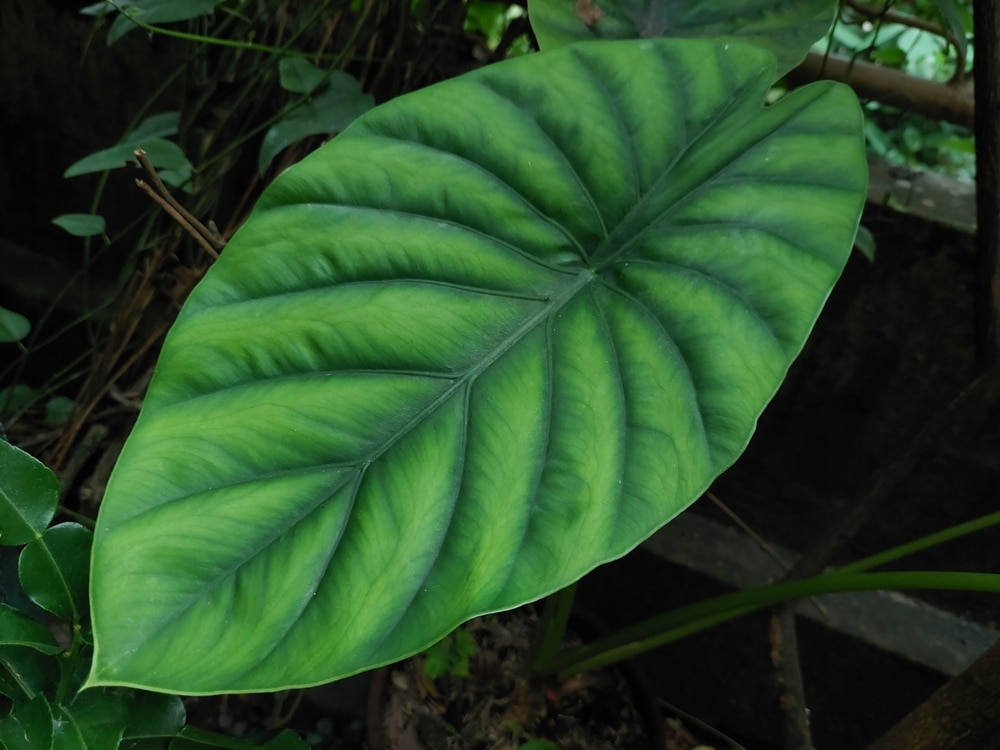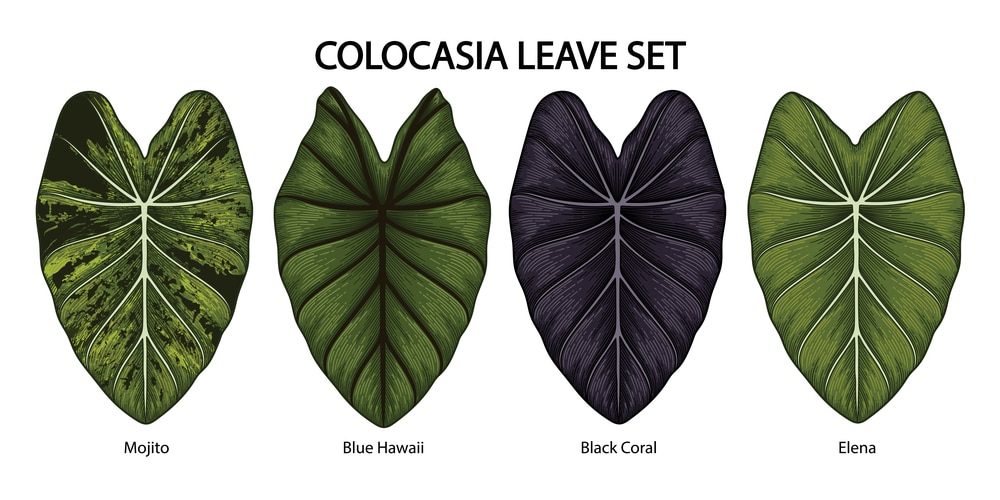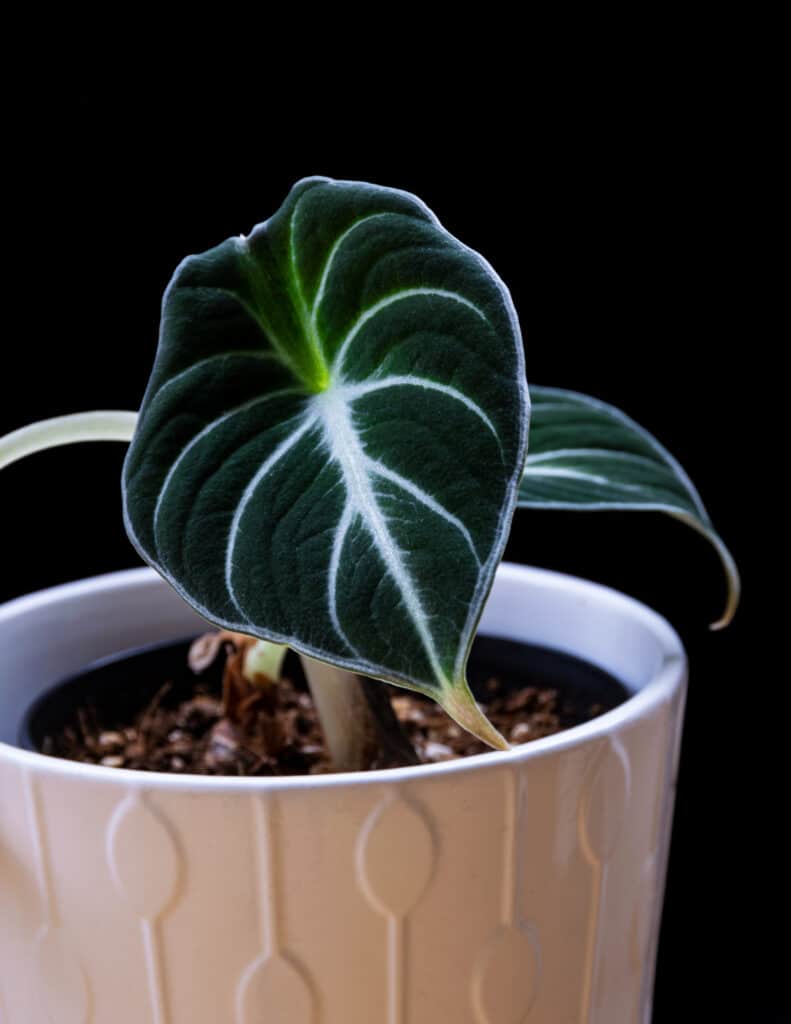There are 4 types of plants referred to as ‘elephant ears’, those being Caladium, Xanthosoma, Alocasia, and Colocasia – but it’s the last two that we’re going to focus on today. Colocasia and Alocasia are the most likely plants that you’ll run into being described as ‘Elephant Ears’.
So, what are the differences? How do you tell the difference between the two? One of them is actually edible, so this is a very useful thing to know and it’s going to be the subject of our article today. We’re going to compare the most popular 2 Elephant Ears in detail so that by the time we’re done, identification on your own should be a breeze.
Let’s take a closer look and address the ‘elephant in the room’ by exploring the contrast between the two most prominent Elephant Ears – Alocasia and Colocasia!
Origins
Our first comparison will be in the area of origin. Let’s take a look at where these plants natively occur to establish our first initial differences and we’ll work up from there.
Alocasia
Alocasia is part of a family of about 97 species that is found natively in Asia and Australia. More specifically, you can find it in China and across many Pacific islands (most notably in the Philippines, Indonesia, and the Caroline Islands) and throughout Southeast Asia.
Colocasia
By contrast, Colocasia (also known as Taro) is comprised of 16 accepted species which originated in the Bengal bay in Southeast Asia and which was then quickly spread across the Pacific Islands and also in Africa, due to it’s viability as a food source because of its edible tubers. Colocasia is considered to be one of the most common plants found all over the western world!

Leaves
Next, we’re going to take a look at the leaves of both of these species. While they are both quite wide enough to earn the ‘elephant ear’ moniker, there are definitely some differences if you know what to look for. Let’s take a closer peek at the distinctions to make between these two.
Alocasia
Alocasia has shield-shaped leaves, which are seated upon long petioles and which have very prominent veins that may be different colors, based on the variety. You might see white, pink, or black green veins, and varieties such as Alocasia Zebrina even have burgundy accents. As far as leaf size, Alocasia Leaves can reach a mature length of 16 – 20 inches with most Alocasia species and they also produce lovely flowers, as well as small, red berry-type fruits.
For identification, check the stems. In Alocasia, the stems are very stiff, so the leaves will be pointing up. If you see this, then most likely you are looking at an Alocasia Elephant Ears plant.
Colocasia
Colocasia also has shield-shaped or ‘arrowhead’ shaped leaves, which is one of the points where it’s easy to get confused. The petioles (stems) of Colocasia are quite distinctive in that they attach at the notch of the leaves. This makes the leaves point downward, making identification a piece of cake!

Aside from the telltale stem placement, Colocasia leaves can grow much larger than the average Alocasia , ranging between 7.9 to 59.1 inches long while the largest, Colocasia gigantea, boasts leaves of 4 to 6 feet in length!. These plants also flower, producing yellow flowers along with white berries.
Size
In this section, we’re going to compare the respective sizes of both Elephant Ears to give you a little more contrast between the two. Let’s see how these Elephant Ears match up in size!
Alocasia
Since we are covering a wide range of species, it’s best to give a general approximation. Alocasia, depending on the species, will grow to be anywhere from 2 to 15 feet tall. This comes with a spread of approximately 2 to 8 feet wide, depending on the variety of Alocasia.
Colocasia
Most varieties of Colocasia are going to fall in the 3 to 5 foot range with a spread of 3 to 6 feet, excepting the Colocasia gigantea and the ‘Laosy Giant’, both of which can grow to be over 9 foot tall with a spread of 6 to 10 feet!
Toxicity
Both of these plants have a degree of toxicity to them, but there is an important distinction that we’ll expound on in the section below. Let’s take a look at how these two compare from this angle.
Alocasia
Alocasia definitely wins when it comes to toxicity. This is a plant that is considered highly poisonous to dogs, cats, humans, and even horses when consumed. Even when touched, skin irritation is likely, as the edges of the leaves of Alocasia has calcium oxalate crystals – you can look, but don’t touch Alocasia. Every part of this plant is considered poisonous when raw, but the fruits and the leaves may be boiled and consumed by most (some will still find them a bit irritating).
Colocasia
Colocasia is quite poisonous too – unless you cook it. The Colocasia/Taro plant is cultivated all over the world, because it’s quite edible if you prepare it right. That said, if you try to eat it raw, it can cause painful swelling of your mouth and lips, vomiting, drooling, and even difficulty swallowing. The feeling is described as being akin to having a mouthful of needles!
When it’s cooked, it’s actually quite safe, and it has been a staple in Asian cuisine for quite some time, as well as African, Indian, and Pacific island diets. Skin irritation may occur if you handle it without gloves before you cook it, but once it’s been boiled up properly then it’s delicious and perfectly safe to eat.
Care
Both plants have made their way into homes, with Colocasia leading in popularity for its comparatively lower toxicity and the opportunity for an exotic snack. Let’s look at the recommended care for each of these plants.
Alocasia
The best soil for Alocasia is generally going to consist of 3 parts – 1 part peat, 1 part perlite, and 1 part regular potting soil. This helps to ensure proper aeration and drainage to help minimize chances of root rot from overwatering.
Direct sunlight can burn the leaves of your Alocasia, so bright and indirect sunlight is best for this plant. Watering should be done when the top 2 to 3 inches of soil are dry during the warmer months, though in winter this plant becomes somewhat dormant and will consume much less.

Colocasia
Colocasia, by contrast, likes a mix of equal parts peat moss and perlite (for the most common, Colocasia esculenta). Colocasia also isn’t afraid of the sun, preferring full sunlight and a lot of humidity. For best results, use a humidifier and mist the leaves regularly to keep your Colocasia happy.
As far as watering, wait until the top 2 inches are dry and then drench your plant until you see water draining out of the pot. If you see any yellowing of the leaves on your Colocasia or your Alocasia, then reduce the amount of water that you are giving them and they should start springing back to health.
What Is the Easiest Way to Tell Them Apart?
As it turns out, the easiest way to quickly tell the two apart when you compare two young Elephant Ears side by side is going to be the stem attachment and the position of the leaves. If the leaves point up, you are looking at an Alocasia variety, while if those shield-leaves are down, you’ve got a Colocasia. The veins are much more prominent and often colorful with Alocasia as well, although when both plants are very young the direction that they are facing is the fastest way to identify them.
Conclusion
As you can see, telling the two Elephant Ears apart is not all that difficult once you know what to look for. While Colocasia is more popular due to it’s availability and it’s side-job as a food source, Alocasia is also a prized plant, for though it’s poisonous, it’s considered quite the exotic beauty.
Whichever plant you choose, you can rest assured that they’ll bring a touch of the tropics to your home and if you take the time to prepare the edible portions, you can get a taste of them as well. Until next time, keep an eye out for those Elephant Ears – as now you know how to tell them apart!

